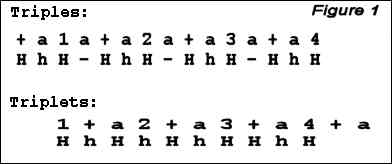Learn to Play the 3-3-7 Pattern with Finger Cymbals
Triples and the next
Variation (Part 2)
ZAGHAREET!
magazine, Sep/Oct 2008by Anthea Kawakib Poole
More Basic Finger Cymbals for Beginners
Yes, all of these drills are on my YouTube channel, but if you want to SEE the patterns written down, these articles will help. Let me know if anything’s unclear or doesn’t make sense to you; but be sure to subscribe for more updates: www.youtube.com/user/DanceEternal.If you're learning on your own, start slow and only do what you can do well enough to practice; don’t be discouraged if the challenging combinations at the end of the second clip take you a while to master. A few minutes of practice several times a week will really make a big difference in the long run!
The mystical number 3!
Last article went over Singles, Doubles, and Rolls.... good basic stuff you need to know before getting fancy. Now we’ll unlock the magic “Triple Whammy” that makes all the fun, fantastic finger cymbal patterns you’ve been itching to play!In my cymbal method, a “triple” is 3 alternating strokes per 1/2-beat (more or less)...and the other half of the beat is usually empty, or silent. If you’ve heard of “triplets”, this ain’t them. (Shades of the notorious “3/4 shimmy” debate.... but that’s another story. And I’ve got my version of that on YouTube too.)
Optional side note on the timing of Triple versus Triplet: instead of 3 strokes per 1/2-beat, a tripLET is 3 evenly-spaced strokes throughout one whole beat. See the timing below (remember we’re using a capital H for the dominant hand and lowercase h for the other one)
But let’s not get too deep into it right now, except to notice that they sure do look different, don’t they? All we’re doing right now is learning to play and understand triples. Triplets is for much later.
Let’s Get a Triple-Play
Sitting down with your cymbals on, play the triple pattern above:H h H (pause) H h H (pause) etc. Count it like this: 1-2-3 (pause) 1-2-3 (pause) etc. As we did in the previous article, you can use a metronome (www.MetronomeOnline.com) - s-l-o-w, at about “66" or so, and on each ‘click’ your dominant hand is playing.
Don’t worry about the beat (1 a + a 2 a + a etc.) yet, that’s next. For now just make sure your dominant hand is starting and ending each triple pattern of 3 strokes. You can see your dominant hand is going to be playing a LOT!
(We’re using the metronome super-slow right now; but when you get on your feet, that’s going to change so get used to this pattern now!)When that’s comfortable for you, we have to change how you’re thinking about it. Now we’ll “put in the numbers” of the beat (also called the “count”): each ‘click’ of the metronome is now a number:
1 2 3 4 5 6 7 8. Give your fingers a rest and just count the clicks several times - out loud is best!Good - now put in the “and a’s” like this, making sure the NUMBERS are still on the clicks:
and a 1 and a 2 and a 3 and a 4 and a 5 etc., but the “and a’s” are NOT on any clicks.
Here we go! Here we go! Here we go! Here we go!
Okay, get on your feet, cymbals ready again; we’ve got to get your body and cymbals in sync!Just stand in place, arms out in dance position (not all curled up in front of you!) and play your triples as above:
H h H H h H H h H H h H (See Figure 2).

(Remember, CAPITAL H = dominant hand; lowercase h = non-dominant hand.)
You see the beat (the numbers) is now “very important”--it’s underlined and bold. Just like when you drilled the Singles, Doubles, and Rolls patterns, you’re going to STEP ON THE BEAT, playing your cymbals too. Here’s how:
Get your metronome (or slow music) going, hear the beat, starting counting it:
1 - - - 2 - - - 3 - - - 4 - - - 5 - - - 6 - - - 7 - - - 8...then add the “and a’s”:
and a 1 and a 2 and a 3 and a 4
(make the numbers a little louder, because they’re important)
Start your cymbals, still counting, and shift your weight from side to side on the NUMBERS.
When that’s comfortable, start walking like a dancer: arms out, spine erect, head lifted, eyes up, stepping gracefully. Please keep your hands still - no jerking or flipping around - that becomes a bad habit really fast.Do this drill for a
while, then change it up like we did previously (with the
Singles, Doubles, and Rolls):
- 4 counts walking playing cymbals, 4 counts walking not playing
- walking in a circle, or walking forward and back
- do your drill in place, with hip sways on your weight changes
- extra points for using your arms: while posing in place, see if you can keep playing your triples pattern while going through a graceful and lovely arm pattern! For instance, 4 counts arms going up to overhead, 4 counts coming back down...
Video - How to Add Triples to your belly dance combinations.
Let me know if you have any questions, I'm happy to help! Be sure to subscribe to my YouTube channel to get updates.
Next, I recommend this in-depth article: How to Play the 3-3-7 pattern